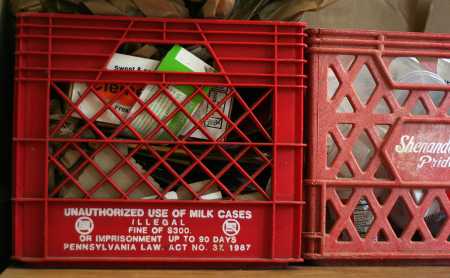
I had no idea either! At home and garden and on our sister site, Craftbits.com, we use milk crates for a variety of projects.
However, if you go by this article in the ModernFarmer, use of milk crates for anything other than carrying milk is illegal and can invite fines up to $300! Or jail time for 90 days.
Holy Cow!
Add to the fact that milk crates are so good as rubbish bins, temporary seats and convenient step ladders and you can see why they are so sought after.
What are your thoughts on this? Have you used milk crates in your DIY projects? Did you know that it was illegal?
Image from the article at ModernFarmer.

Actually, I did know this. When I started college (so long ago I don’t want to mention it) we were told that we couldn’t use milk crates in the dorms for this reason. And if we caught, blah blah blah.
Now, we have a huge after-market of non-milk “milk crates”. Free is always nice, but they are reasonably priced, esp during back-to-school sale time. You might also find them as college kids leave stuff as trash when they move out.
If you are wondering if they are free for the taking ALWAYS ask. My son met a kid that was doing community service at the dumb because he got arrested for taking palettes from behind a store. He thought they were free for the taking. Yikes!
You can still use crates that are designed to look like milk crates or antiques that are no longer in use, but it’s always been illegal to steal them from the grocers.
I’ve always thought they were fun to use in many ways, I have some that are over 20 yrs old (dating myself lol) but they are decorator bought at Target because people were getting in trouble for stealing them from the back of the grocers. We forget sometimes, just because it’s set out doesn’t mean it’s free for the taking.
I knew it was illegal awhile back but that’s because someone told me. We bought a couple at Wal-Mart – one for the car for milk 😉 and one for my sewing area.
It’s much cheaper and MUCH more legal to just invest the 10.00 in one at an office supply store. Besides, they’ll be cleaner, and will match!
no I didn’t know that using them was illegal… my kids found loads of them in the trash ( so maybe mild delivery people and grocery stores ought to take better care of them?) and used them in college for all sorts of things just like you mentioned. They even used the old metal ones that took glass quart bottles. AND I don’t think any of them had the disclaimer on the side that you photographed!
*Hee hee* The police officer who lives down the street has a crap-TON of ’em in his garage, storing everything from old LP’s to motor parts…I don’t think I have to worry about the handful of ’em I have around the house….
the crates in the photo are clearly marked regarding the consequences of using them other than for their intended purpose by the owners of the milk company. seems to me that if they are not clearly marked or even marked at all then no laws have been broken. unless of course maybe this is a Pennsylvania law. it certainly is not a Mississippi law that I know of.
I have a vintage china rental business and I use new unlabeled milk crates that I buy from The Container Store for $9.99 each to pack and transport my rental dishes. At a wedding recently, I found that one of them was missing as I was repacking the dishes to transport home. It was found in the car trunk of one of the guests. I found it odd that he wouldn’t have realized he was stealing my property, but maybe he’s like everyone else who takes them from the milk companies.
My husband worked in dairies for 18 years so yes I knew that they belong to the dairies and when people walk off with them it costs the dairy a lot of money to replace them. I also know that when a crate is no longer suitable for commercial use the plastic is recycled. Unfortunately the part time clerk at the local convenience store may not know this and they may even help someone load them into the back of their vehicle.
I also know that wood pallets belong to someone. New ones are not inexpensive and they are reused as many times as possible. Eventually they do break down to a point where they can’t be reused and some owners would be happy to let you have the broken ones. But you have to find and ask the pallet owner.
here in Belgium we got blue crates, from the post office. they’re normally used by companies to collect the mail and take it to the post office… but most of all they’re used to take documentation to fairs or to store all sorts of supplies… that’s illegal as well… I guess they’re just too convenient
Yes, I knew, and yes, I have a dozen or so, and yes, I do feel guilty about it and think about it often. And still use them. I can’t recall where I acquired them–not from behind stores. I’m not quite that crass. I suppose they were discarded by other people who took them from who knows where. Many of the dairies have gone out of business. What would I do with them if I tried to return them? They are very useful around the yard, and in the basement. Cringe (and I live in PA!) Every once in a great while the dairies run a campaign to get people to return them, with limited success. Mine look so shabby, I wouldn’t want milk delivered in them.
As for pallets, sometimes they’re sold to companies that reuse them, sometimes they’re trashed. My husband works in a warehouse where they consider them a headache. They pile up outside and are used by skate punks at night, who then leave a mess behind. They have to get someone to haul them away periodically. Sometimes he brings some of the nice ones home to me and I put them to good use. They used to donate them to a fall bonfire, but I think they stopped doing that. Not good for the grass, or the air quality.
Interesting points to ponder. Thanks.
I’ve known it for YEARS, that’s why the only SAFE way to do this is to buy the milk-crate type crates that they have at Wal-Mart, Staples, etc. Then it’s all legit!!!
I was in law enforcement for 26 yrs. Not once did I arrest anyone for illegal milk crates nor do I know of any other officer who did. If it was that big of a deal there would be a Milk Crate Division at the Police Department. Don’t lose any sleep over the milk crates in your garage . Unless your stealing them from behind stores you don’t have anything to worry about.
I have two dogs that love to nap in their crates or under the covers. If you don’t have a secret spot for your pets already, turn a milk crate on its side, lay a soft blanket in the bottom of the crate, and drape another blanket over the top with space for the animal to walk in and out